Sometimes, you need to move or update a DLL file, but you receive an error message saying : « Access denied ».
It’s not always a file access right problem.
Mayby this library is currently used by a process. To found out which one, just type use the tasklist command in a DOS / Powershell prompt :
tasklist /m my_dll.dll
Simple !
Clap de fin pour Nantes en Direct…
Clap de fin pour Nantes en Direct…
C’est fini pour l’application « Nantes en Direct » que j’avais développé en 2012… pour Windows Phone !
A l’époque je n’étais pas satisfait des agrégateurs d’actualité, j’avais donc décidé de m’en charger ^_^

L’appli s’appelait « Nantes Live » au début, mais j’ai du changer car la société « France Live » revendiquait le droit d’utiliser les noms des villes suivis de « live » pour leurs applis…
En 2015 je sors la version Android (et iOS, mais le développement sur Mac m’a rebuté, et je l’ai vite retirée).
Depuis il y a eu plus de 10 000 téléchargements, dont 2/3 sur Android !
Je décide d’arrêter, car je n’ai plus le temps de gérer les bugs et les évolutions des sites d’information que je dois surveiller. Etant parti de Nantes, la maintenance est d’autant plus difficile.
J’estime à environ 500 utilisateurs quotidiens, auxquels j’envois toutes mes excuses pour cette rupture brutale du signal.
Merci à tous, et merci pour vos remarques qui m’ont permis d’enrichir cette petite appli bien pratique, qui m’accompagnait au quotidien durant ma vie nantaise.
Bye !
Create a link that initiates a Nintex Workflow associated to a Document Set

It’s been a long time since my last post !
I’ve moved to Geneva for a new job, but I’m still on SharePoint and other Microsoft stuff 🙂
Nintex is used a lot in Switzerland. I had an issue about creating a client-side script that initiates a workflow. I did not manage to do it with « StartWorkflow » from workflow.asmx. As usual with document sets, a specific treatment is needed.
So, this is the link that you can use :
/_layouts/15/NintexForms/InitiateWorkflow.aspx?List={xxx}&ID={yyy}&ItemGuid={zzz}&WorkflowName=MyNintexWorkflow
Where xxx is the list Guid, yyy is the document set ID (as displayed in docsethomepage.aspx?ID=yyy), and yyy is the UniqueId of the document set.
SharePoint : How to filter an external data XsltListViewWebPart in SharePoint Designer ?

Context : You use Business Data Connectivity to retrieve external data in SharePoint, and you wish to display a filtered view of this data in a page.
In SharePoint Designer, you insert a Data View of that external data.
Then, there are 2 ways to filter it :
- By using the « Filter » button in the office ribbon :
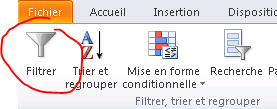
This actually generates a CAML query :
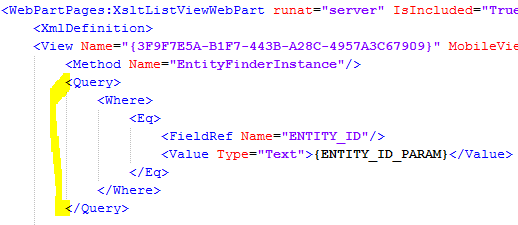
- By passing a parameter to the finder method of the BDC Model. You can do this manually or by using the « Search » button :

It generates this code in the View element :

You should use the second solution. Why ? We could consider the CAML query as a « front-end » filter. It means that ALL the records are sent by the BDC, and then the CAML query filter it.
If you retrive thousands of records, it can affect performances.
If you pass a parameter directly to the BDC (finder method), the request sent to the external source will be filtered, and SharePoint will have to deal with less data.
Maybe you will have to create a new finder method in your BDC, but it worth the time spent on it !
SharePoint 2013 : How to repair a broken Search component at low cost

Once upon a time, after a whole server farm reboot, one of my search component was broken. Content crawling was taking forever, and the ULS were not very explicit. In the central administration, I could see this :

My application server was unable to run the « Content Processing Component », even if I restart the whole search service (net stop / start OSearch15).
I noticed 2 things that drove me to the solution :
– First, a noderunner.exe process was missing. This confirmed the red cross in the central administration. There was 2 processes instead of 3 (the crawler doesn’t spawn a noderunner.exe process) :
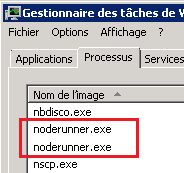
– On the second hand, there was strictly no logs in the « 15.0DataOffice ServerApplicationsSearchNodesContentProcessingComponent » directory !
It was like the search topology was ignoring this component. So I decided to re-install the search topology, just by cloning it, and activating it :
$searchApp = Get-SPEnterpriseSearchServiceApplication
$initialTopology = Get-SPEnterpriseSearchTopology -SearchApplication $searchApp -Active
$cloneTopology = New-SPEnterpriseSearchTopology -SearchApplication $searchApp -Clone -SearchTopology $initialTopology
Set-SPEnterpriseSearchTopology -Identity $cloneTopology -SearchApplication $searchApp
And it works, without any service interruption !

SharePoint 2013 : Empty term set in user profile property edition
 If you add or edit an user property (in the User Profile Service – UPS), you can map a term set.
If you add or edit an user property (in the User Profile Service – UPS), you can map a term set.
Surprisingly, the list box will be empty, even if you are full admin of the Managed Metadata Service (MMS) :
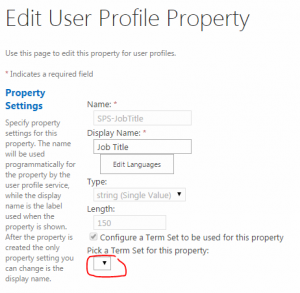
How to fix it :
– Navigate to « Application Management » > « Manage Service Application ».
– Select the line « Managed Metadata Service Connection« , and click on « Properties » :

– Check « This service application is the default storage location for column specific term sets ». and click on « OK ».

Now, you are able to browse MMS and choose a term set for your profile property :

Are there any side effect ?If your SharePoint farm hosts only one MMS, it should be OK. In a rare case where you have to deal with other MMS, you should check how these services are configured. You might have to change proxy associations for these service applications.
Azure : Faire cohabiter du PHP et du .NET sur un même site, c'est possible !
 Dans Azure, le cloud de Microsoft, il est possible de faire héberger un site web qui contient des pages .NET et PHP.
Dans Azure, le cloud de Microsoft, il est possible de faire héberger un site web qui contient des pages .NET et PHP.
Avec le recul, ça peut paraître évident. Mais j’ai été surpris au premier abord.
Dans l’onglet « Configuration » du site, il suffit de vérifier si les 2 frameworks sont activés :

(Désolé, c’est une capture de l’ancien portail Azure, mais je ne peux pas encadrer le nouveau portail avec son UX horrible)
Du côté de Visual Studio, ça se présente ainsi, pas besoin d’installer une extension du genre PHP Tools, il suffit d’ajouter ses fichiers PHP à la solution :
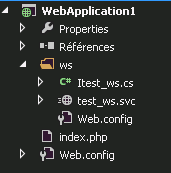
Je me suis aperçu de tout cela en implémentant un back-end web-services en C# sur ma vieille appli PHP des années 90. Et ça marche nickel !
NB : Je ne serai pas étonné qu’on puisse également ajouter du JAVA et du Python, afin d’obtenir une application web œcuménique où les langages cohabiteraient en paix.
SharePoint 2013 : Email notifications are not sent (from My Site's newsfeed)
 Context : Users of your SharePoint web applications can receive email alerts, but they are never notified by all the « My Site » activities, such as « Someone has started following you » or « Someone has mentioned you ».
Context : Users of your SharePoint web applications can receive email alerts, but they are never notified by all the « My Site » activities, such as « Someone has started following you » or « Someone has mentioned you ».
In the SharePoint logs (ULS), you can see errors like:
Failed attempt x sending mail to recipients: surname.name@mycompany.com. Mail Subject: NAME Surname mentioned you in a conversation. Error: SmtpException while sending email: System.Net.Mail.SmtpException: Mailbox unavailable. The server response was: 5.7.1 Client does not have permissions to send as this sender
Solution : These notifications seem to be sent in an authenticated way, by the app pool service account (unlike the standard emails (alerts) that use the address defined in the « outcoming email » in central administration, in an anonymous way). So you have to add the right « Send-As » to this account in Exchange.
NB : If it doesn’t work, grant this right to the SharePoint Timer service account as well. I still have a doubt on this one :/
Source : Technet forum
IIS : Erreur lors de la déclaration de l'identité d'un pool d'application
 Sur un serveur qui fonctionnait parfaitement (c’est à dire que IIS tourne et les sites répondent), je crée un nouveau pool d’application avec un compte d’annuaire comme identité. Et là boom, erreur de type « Données incorrectes » (HRESULT : 0x80090005) :
Sur un serveur qui fonctionnait parfaitement (c’est à dire que IIS tourne et les sites répondent), je crée un nouveau pool d’application avec un compte d’annuaire comme identité. Et là boom, erreur de type « Données incorrectes » (HRESULT : 0x80090005) :

Ou plus sexy en Powershell :

Dans un premier temps, on pourrait croire que le mot de passe du compte est erroné. Mais ce n’est pas le cas. Quand cette erreur survient, le serveur a déjà vérifié la validité du compte.
Comment IIS encrypte les mots de passe ?
IIS encrypte les mots de passe en utilisant différents providers qui sont stockées dans le fichier applicationHost.config (%SystemRoot%System32inetsrvconfig), dans la section <configProtectedData>, par exemple :
<add name="IISWASOnlyAesProvider" type="Microsoft.ApplicationHost.AesProtectedConfigurationProvider" description="Uses an AES session key to encrypt and decrypt" keyContainerName="iisWasKey" cspProviderName="" useOAEP="false" useMachineContainer="true" sessionKey="*****" />
Le provider « AesProvider » est utilisé pour crypter et décrypter les sections system.webServer.
Le provider « IISWASOnlyRsaProvider » est utilisé pour crypter et décrypter les sections dans le applicationHost.config.
Quant aux clés d’encryption, elles sont dans C:ProgramDataMicrosoftCryptoRSAMachineKeys, et elles sont uniques à chaque serveur !
Conclusion : Cette erreur viendrait du fait que les providers décrits dans applicationHost.config ne correspondent plus aux clés du serveur.
Que s’est-il passé ?
Il y a évidemment plusieurs scénarii qui aboutissent à ce problème, mais le plus simple est le suivant : le fichier applicationHost.config a été écrasé à partir d’une copie d’un autre serveur.
Comment résoudre ?
Il y a plusieurs solutions aussi, plus ou moins douloureuses :
– Restaurer le fichier applicationHost.config s’il a été sauvegardé,
– Réinstaller le rôle « Serveur web »,
– Importer également les clés du serveur d’origine. Cet article explique bien le problème et la manipulation à faire.
Un autre article intéressant explique tout cela en détail : MachineKeys on IIS 7.x : Inside Out.
SharePoint 2013 : How I fixed my corrupted AppFabric Cache Service
 I have faced some troubles with Ditributed Cache… (again ?)
I have faced some troubles with Ditributed Cache… (again ?)
Especially when I tried to change the service account of the AppFabric Caching service, as explained here.
Then, my services seemed corrupted, it was impossible to restart them properly (Restart-CacheCluster command).
Their status was stuck on STARTING for a few minutes, and then went DOWN :
PS C:Userssp_admin> Use-CacheCluster
PS C:Userssp_admin> Get-CacheHost
HostName : CachePort Service Name Service Status
-------------------- ------------ --------------
Server1:22233 AppFabricCachingService DOWN
Server2:22233 AppFabricCachingService STARTING
And I had this error in the Windows Event logs (Event ID 1000 and 1001) – Seeing a failing KERNELBASE.dll module is not very reassuring !
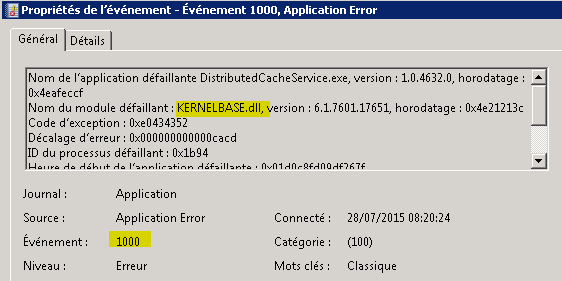
This is what I have done to fix it. BEWARE that a corrupted distributed cache can result in resinstalling SharePoint from scratch ! So please be careful.
1- Stop all the SharePoint Distributed Cache service instances (on each WFE) :
Use-CacheCluster
Stop-SPDistributedCacheServiceInstance -Graceful
Remove-SPDistributedCacheServiceInstance
Use this code to force the uninstall :
Get-SPServiceInstance | ? {($_.service.tostring()) -eq "SPDistributedCacheService Name=AppFabricCachingService"} | % { $_.Server; $_.Status; $_.Id }
$s = Get-SPServiceInstance <GUID>
$s.Delete()
2- Unregister all hosts (on each WFE) :
Unregister-CacheHost
3- Register all hosts :
Register-CacheHost -Provider "SPDistributedCacheClusterProvider" -ConnectionString "Data Source=DBAlias;Initial Catalog=SPServer2013_Config;Integrated Security=True;Enlist=False" -Account "DOMAINSP_DistributedCache" -CachePort 22233 -ClusterPort 22234 -ArbitrationPort 22235 -ReplicationPort 22236 -HostName Server1
- The parameter « Account » must be the managed account that run the service (as displayed in the central administration).
- The parameters « Provider » and « ConnectionString » must be copied from the following file « C:Program FilesAppFabric 1.1 for Windows ServerDistributedCacheService.exe.config »
- The parameter « HostName » must be changed as well.
4- Start each cache host (on each WFE) :
Start-CacheHost -ComputerName Server1 -CachePort 22233
5- Restart all the servers
6- Create the SharePoint Service Instances (on each WFE) :
Add-SPDistributedCacheServiceInstance
Everything went well then. These 2 commands showed me that the services were Online, and the AppFabric Services were marked as UP :
Get-SPServiceInstance | ? {($_.service.tostring()) -eq "SPDistributedCacheService Name=AppFabricCachingService"} | % { $_.Server; $_.Status; $_.Id }
Use-CacheCluster
Get-CacheHost